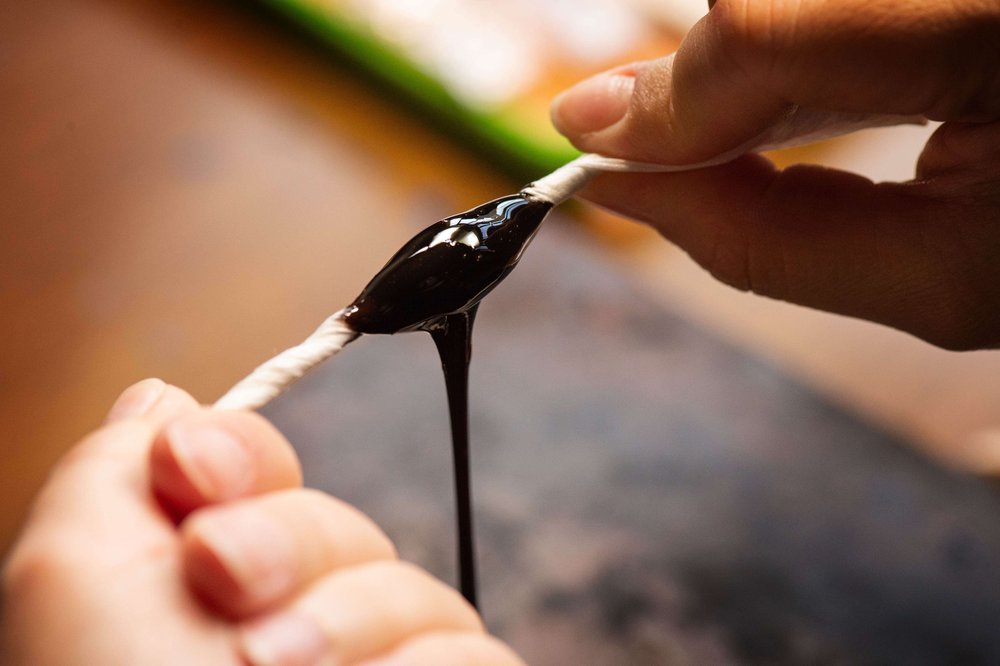What is urushi lacquer ?
Urushi is a special lacquer fabricated from the sap of the Urushi tree, which is native to Japan, China, and Korea. Lacquer sap (which happens to have some pretty nasty toxic qualities in its “raw” state) is frequently used as a lacquer in Japan because of its very resistant properties. Indeed, it contains a resin that becomes very hard, durable, and plastic-like when exposed to moisture and air. Owing to its potential toxicity, it is not the easiest or most forgiving substance to work with.
Makie – The Japanese art of gold sprinkling
Maki-e is a decoration technique, that literally means “Sprinkled picture”.
In Japanese lacquer art, some of the most delicates pieces are decorated with the process of maki-e. This thousand year old technique consists in sprinkling the lacquer with tiny particles of metal (it can be gold or silver like for Minase). The resulting design is then set into place with other layers of urushi lacquer.
The metal dust is applied using bamboo tubes and small brushes. It is a very old technique and only a few urushi masters remain today. Minase is proud to work with one of them, a woman called Magumi Shimamoto.
Minase’s urushi makie dials
Minase’s urushi makie Divido pays tribute to Japan’s finest traditional crafts. Following the success of the blue hand-lackered embossed copper dial of the Divido standard series, Minase has launched a special, artisanal version! This latest offering features a deep blue, red or green Urushi silver makie dial. Handcrafted in the Kyoto studio of Megumi Shimamoto, a master of traditional Urushi work, there new Divido dials need many hours to be crafted.

Minase’s urushi dials – the process
After blending and straining the Urushi, the copper base dial is painted with a first layer of lacquer. Urushi lacquer is applied with a brush to the copper dial. Traditional Urushi brushes were made out of human hair because its texture was found to be just right. It is hard to find this kind of brush today even among traditional artisans. They mostly use brushes with mice or cats hair.
As the urushi lacquer hardens, it absorbs moisture from the air which makes the dial perpetually shiny and slick. It isn’t really useful for a dial that’s inside a watch case, but the Urushi lacquer also withstands erosion from water, acids, alcohol and changes in temperature.
To create a maki-e dial, the silver powder is applied before the lacquer dries. The powder is sprinkled over the dial with the use of a special wooden tool. Owing to the strong adhesiveness of lacquer when it dries, the powder will stick and harden. Another layer of lacquer, a mixture of blue pigments and transparent Urushi is then applied acting as a seal. The process is repeated twice.
After drying, the dials are polished several times enabling the silver powder to shine out. Thereafter, the dials are exposed to sunlight in order to bring out the color to its final shade. Lastly, the Minase logo is printed.
The creation of one piece of Urushi art is very time-consuming. The careful application of many layers and the drying times between them can take weeks.
Urushi Lacquer’s Origin
The traditional urushi lacquer comes from the sap of the Asian lacquer tree – toxicodendron vernicifluum, also called Urushi tree. It is not easy to cultivate as it is highly allergetic. A couple of slashes are made in the tree and the freshly collected sap (called “arami”) is grey-brown in color and includes impurities that need being removed. Hence, the sap is filtered several times through layers of paper.
Megumi Shimamoto, based in Kyoto, is a master of the Urushi craft. For this blue Urushi and silver maki-e dial edition, she used one of the most simple techniques to produce Maki-e, as it had to display one color only and no motives. Nonetheless, she spent many hours to complete every single dial.






